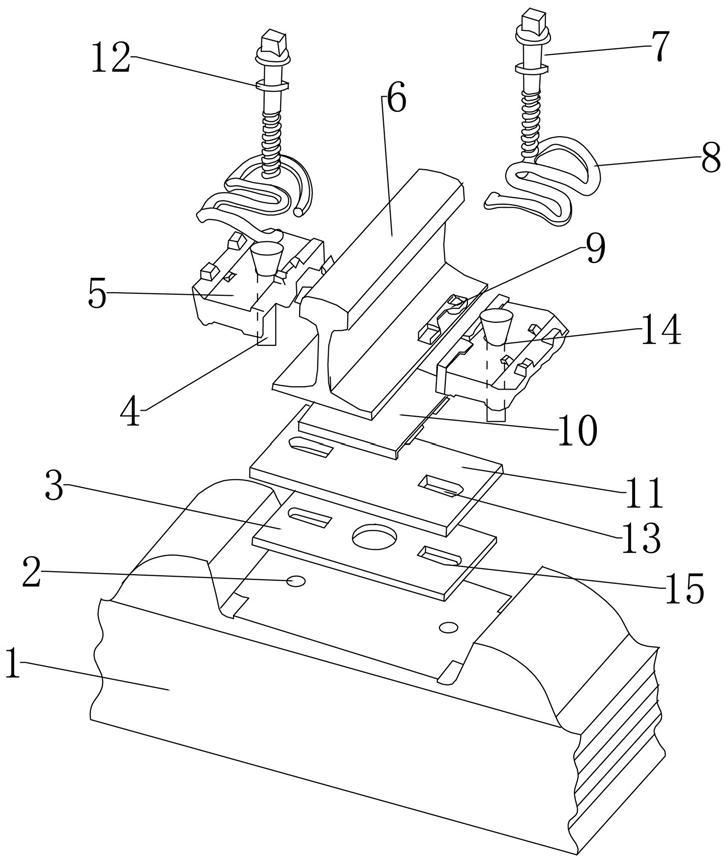
Anyang Railway Equipment Co., Ltd Invented a Railway Rail Fastener with a Sand Guard
After the High-Speed Railway Rail Sleeper is put into use, it needs to be repaired after some time. In the North Western of China where there is more wind and sand, due to more windy weather, some railway lines often cause serious sand accumulation, especially near the screw spikes of the rail fasteners. There is a lot of sand. During normal daily maintenance operations and manual disassembly and assembly of the fasteners, the screw spikes need to be pulled out. At this time, the accumulated sand will flow into it, causing the screw spikes to be unable to be screwed in place during reassembly, which will affect the buckle pressure of screw spikes, it is necessary to clean up the sand in the threaded hole of the embedded dowels before fastening the screw spikes.
Usually, the daily maintenance team adopts the method of using an air pump and a sand scoop to remove the accumulated sand before the installation of screw spikes in the sand-accumulated area. Generally, it needs an average of 5-10 minutes to clean each threaded hole, which affects the speed of fine adjustment on site, and brings great inconvenience and safety hazards to daily maintenance operations. Therefore, there is an urgent demand for an accessory that can prevent the sand near the screw spikes from flowing into the threaded hole of the embedded dowels when manually disassembling and assembling the fastener to extract the screw spike, so as to improve the maintenance efficiency of the sand accumulation section in the wind area and reduce the time required for daily operations to clean up the sand in the threaded hole of the embedded dowel, and eliminate the hidden danger of insufficient bolt torque caused by the sand.
In order to solve the above problems, Anyang Railway Equipment Co., Ltd invented a fastener with a sand guard. The sand guard passes through the gauge baffle plate, the iron tie plate, the elastic tie plate and the embedded dowel in the sleeper in sequence, and is manually disassembled and assembled. When the fastener is pulled out of the screw spike, it can prevent the sand near the screw spike from flowing into the threaded hole of the embedded dowel, which improves the efficiency of the maintenance work in the sand accumulation section of the wind area.
The invented fastener with a sand guard, composed of rail sleeper and a embedded dowel in the sleeper, an elastic tie plate is arranged above the sleeper, and an iron tie plate is arranged above the elastic tie plate. The under-rail pad is set above the iron tie plate, the steel rail is set above the under-rail pad, the gauge baffle plate is set on both sides of the rail, and spring clips, flat washers and screw spikes are set above the gauge baffles. A gauge baffle with one bolt hole, the iron tie plate has two bolt holes,and the elastic tie plate has two bolt holes.
.jpg)
.jpg)
The bolt holes of the gauge baffle plate, the bolt holes of the iron tie plate, the bolt holes of the elastic tie plate and the embedded dowel with sand guards, and the screw spikes are fixed in turn through the flat washers, spring clips and sand guards into the sleeper.
The sand guard passes through the spring clips, the bolt holes of the gauge baffle plate, the bolt holes of the iron tie plate, the bolt holes of the elastic tie plate and the embedded dowel is connected with the sleeper at the bottom of the embedded dowel.
The top of the sand guard is connected with a flat washer, and the diameter of the opening at the top of the sand guard matches the diameter of the flat washer close the opening on the top of the sand guard by the flat washer.
The sand guard is a rubber sleeve with a through hole in the middle. The sand guard is integrally formed. The upper part of the sand guard is in the shape of an inverted truncated cone and the lower part is a cylindrical shape. The through hole penetrates the upper and lower parts of the sand guard.
There are two gauge baffle plates, which are matched with the two ends of the iron tie plates, and both sides of the steel rail are provided with insulating gaskets.
The beneficial effects of the invented fastener are: the sand guard uses a soft rubber sleeve in combination with the gauge baffle plate and the size of the screw spike to make a special shape sleeve. When the screw spike is tightened, the lower part of the sand guard is in close contact with the rail sleeper, and the upper part is sealed by a flat washer. The upper and lower parts are closed to prevent sand from penetrating into the sand guard; the outer edge of the sand guard is kept at a certain distance from the threaded hole of the embedded dowel, and the lower part of the sand guard is cleaned. When the sand on the side accumulates, the accumulated sand will not flow into the threaded hole of the embedded dowel.



